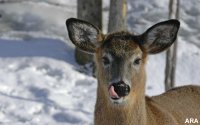 (ARA) – With fall and winter right on our heels you’re probably thinking you’re out of the woods when it comes to deer damage in your backyard landscapes. Wrong. Actually, fall and winter mark the beginning of the worst seasons for deer damage to your landscapes. Deer will eat just about anything in the winter — their food supply is low and they can’t be choosy. They are hungry enough in the winter to eat vegetation that they ordinarily would not eat.
(ARA) – With fall and winter right on our heels you’re probably thinking you’re out of the woods when it comes to deer damage in your backyard landscapes. Wrong. Actually, fall and winter mark the beginning of the worst seasons for deer damage to your landscapes. Deer will eat just about anything in the winter — their food supply is low and they can’t be choosy. They are hungry enough in the winter to eat vegetation that they ordinarily would not eat.
As with other wildlife, land development has reduced deer’s natural habitat. Combine that with a lack of natural predators and easy access to your landscapes and modern-day deer not only survive, they thrive!
The most important thing to understand about fighting deer is that it’s easier to prevent damage than to react to it. So it behooves you to know your enemy and stay at least one step ahead of them. Deer are creatures of habit — they establish feeding patterns and return to the same spot over and over again, even when that same spot stops offering enough food for them.
You can be sure deer have been munching on your landscapes this fall and winter if you see:
- Rub marks on trees where bucks have rubbed their antlers to mark their territory; the tree bark is actually rubbed off.
- Any kind of torn vegetation is also another telltale sign. Deer do not have incisor teeth, and therefore, they ‘rip’ the vegetation when they bite into it.
- If your damage is found off the ground, up to 6 feet, you can be sure small animal damage can be ruled out.
- Deer tracks are also easy to identify. The prints are about 2 to 3 inches long and are shaped like broken hearts.
So what do you do to keep the deer out of your backyard? There are loads of ‘home remedies’ that have been tried with varying results â
